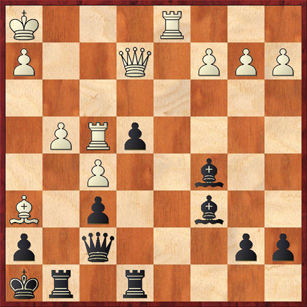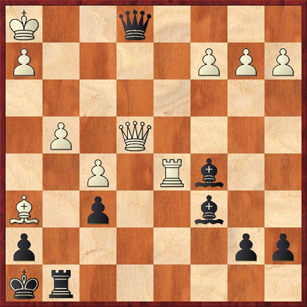Every now and then I like to use this blog to take you “behind the scenes” and tell you some things that were left out of my ChessLectures.
Last Friday’s lecture on Double Queen Sacs, or the “Henry VIII theme” (in honor of Henry VIII, who sacrificed two queens …. get it?), was one of the most fun lectures I’ve ever done. Even the title makes you do a double take … wait a minute, a double queen sac? Is that really possible? Of course, the fun (and hard) part was actually finding some examples.
As it turned out, the first example I found, which gave me the idea in the first place, did not make it into the lecture. Here’s the story. I had a completely different idea for a ChessLecture, which was to look for games between two players with the same names. There were a couple of recorded games between Milan Vidmar, Sr. and Milan Vidmar, Jr. Also, there have also been other Robert Fischers besides the world champion; there is now another Tigran Petrosian (who won a couple tournaments in the U.S. this year); and there was a well-known duplication of names between Grandmaster Larry M. Evans and International Master Larry D. Evans.
Unfortunately, this idea went nowhere, because as far as I can tell Bobby Fischer never played any of the other Robert Fischers, and the modern-day Tigran Petrosian is way too young to have played the former world champion. I had high hopes that Larry Evans might have played Larry Evans at some point, because they were active in roughly the same era. However, a search at www.chessgames.com failed to turn up any games.
However, my search did turn up an unexpected gold nugget. If you go to the player information page for Larry D. Evans at chessgames.com, you will find a few comments posted by readers in the “Kibitzer’s Corner.” On November 6 last year, a reader whose handle is “whitebeach” posted a fantastic game that he had played against Larry D. Evans in 1979. It wasn’t a tournament game; it was just a skittles game played at the Marshall Chess Club. Whitebeach says he saw this guy at the club who looked like he wanted a game. He looked vaguely familiar, but Whitebeach didn’t know who he was. Eventually they reached this position, with Whitebeach as White and Evans as Black:
Black to play and win.
Whitebeach has just played the unbelievably atrocious move 22. g4??, opening up the diagonal leading to his king. Not that he had many better options; he was already a piece down and did not have any visible counterplay.
In this position, the simple and obvious 22. … e3+ is very effective; after 23. Kg1 Qh5 Black wins a second piece and obviously is easily winning the game. However, that was far too prosaic for Evans, who instead played
22. … Qc4!!
The idea of this move is simply to deflect White’s queen away from its blockading square on e2, so that Black can march his pawn unobstructed to the back rank. Of course Black doesn’t have to take the queen sac, but in an informal chess club game, that wouldn’t be very sporting, would it?
23. Qxc4 e3+ 24. Rd5 … (Of course, if 24. Kg1 e2+ and wins. White is hoping that Black overlooked the rook interposition.) 24. … e2! 25. Re4 … (White desperately attempts to stop Black’s pawn. If 25. Qxc5, Black checkmates after 25. … e1Q+ 26. Kg2 Re2+ 27. Kh3 Bxd5 28. Qxd5 Qg1.) 25. … Rxe4 26. Qxe4 e1Q+!! (diagram)
The second queen sacrifice ends the game. If White takes, it’s mate in two; otherwise, Black just wins the house. Whitebeach resigned here.
In his comments, Whitebeach says he was so awed by this game that he immediately wrote down the moves.  A couple weeks later, he was flipping through Chess Life and saw Larry Evans’ picture above his column, “The ABC’s of Chess.” After that, he knew who his mystery opponent had been! “It’s hard to forget a person who makes two queen sacrifces against you in the same game,” he writes.
Of course I wanted to tell this story in my ChessLecture, but for several reasons it’s really not such a great example. First, White’s play in this game was really bad. Second, the game was already over when we got to the first diagram. It’s like a basketball game where one team is ahead by 30 points; as the sports announcers would say, it’s “garbage time.” A sensational play in garbage time just doesn’t mean as much as a great play when the game is still in doubt. Third, Black had many ways to win from the diagrammed position; the queen sac was only the most spectacular. Fourth, it wasn’t played under tournament conditions, and fifth, we don’t even know the real name of one of the players.
I still would have showed this example in my lecture, if not for the fact that I turned up three other examples that had fewer blemishes (in my opinion). I did a practice run-through of my lecture with all four examples, but it took too long, and so I regretfully decided to omit this one.
Even so, Evans’ final combination is wonderful, and I have to thank Whitebeach (whoever he is!) for providing me such a great lecture topic.





{ 2 comments… read them below or add one }
The World’s Greatest Chess Prodigy
Hou Yifan (born February 27, 1994, in Xinghua, Taizhou, Jiangsu, China) is a Chinese chess prodigy, who in 2008, became the youngest ever female in history to qualify for the title of Grandmaster, the highest a chess player can attain. In 2007, she became China’s youngest ever National Women’s Champion. In the July 2008 FIDE rating list, she is ranked the strongest girl player and the fourth strongest female player in the world. On September 12, 2008 she became the youngest ever finalist for the Women’s World Championship title.
enjoyed reading this behind the scenes story! i always wondered how you at chesslecture.com come up with your lecture ideas. i’d like to read more 🙂